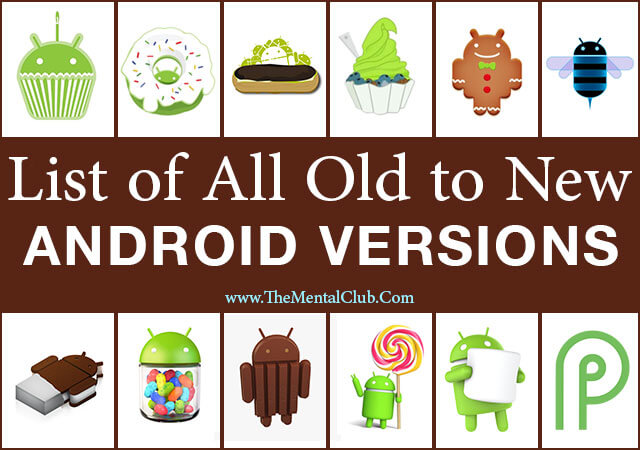

#Android os versions and names android#
However, Mobian sets out to bring an alternative mobile OS to Android which is quite nice. Needless to say, it does not support Android apps and the app support is limited. There is also Terminal support, in case you want to dive deep into the system. It comes with all the basic apps including a Calculator, Camera, Call, Settings, and more. Unlike Android, it runs Linux apps and the UI is surprisingly good. Currently, it does not support a whole list of devices, but Mobian can run on PinePhone, Poco F1, OnePlus 6, and some more devices. Mobian, as the name suggests, is a Debian-based operating system for mobile devices. Open-source operating system, based on LinuxĬannot match the third-party app support of Android I would say if you want to try an open-source OS similar to Android, do give a look at Ubuntu Touch. Not to mention, you get all the necessary apps including the Camera app, Music, Gallery, Terminal, Clock, Dialer, etc. There are also 81 devices that are community supported so in terms of device support, Ubuntu Touch excels. Currently, Ubuntu Touch supports PinePhone, PineTab, Fairphone, Volla, Nexus 5, and OnePlus One. The UBports community also claims that none of your data leaves your device unless you explicitly allow it which is a good thing from the privacy point of view. Using Plasma Mobile, many Linux distros for phones have been released, but the most popular one is postmarketOS. Note that, it does not run Android apps, instead uses the Kirigami UI framework to create apps for Plasma Mobile.

#Android os versions and names skin#
To make the skin look fluid and mobile, it uses a Plasma Shell that feels polished out of the box. It has been developed using the multi-platform toolkit Qt and KDE framework that powers so many Linux distros out there. Unlike many other Android forks, Plasma Mobile is an Android alternative that runs on top of a Linux distribution. The visual style is quite good, gesture navigation You can try Sailfish OS on Sony Xperia phones and Gemini PDA. Apart from all that, Sailfish OS has a distinct visual style and the gesture-based apps are fun to use. In terms of security, Sailfish OS is quite good and the company is making an investment to make it even more secure. All the connectivity and traffic runs behind a firewall with support for VPN. In Sailfish OS, user data is fully encrypted by its sandboxing solution called Firejail. Even Edward Snowden endorsed GrapheneOS and said that “ If I were configuring a smartphone today, I’d use Daniel Micay’s GrapheneOS as the base operating system“. GrapheneOS, earlier known as CopperheadOS, is also developed on Android, but the main developer, Daniel Micay has worked extensively to make GrapheneOS a completely secure mobile operating system. It’s a security-hardened operating system, built with top-notch privacy protection in mind. If security and privacy are your main reasons behind your search for an Android alternative, GrapheneOS fits the bill perfectly. To sum up, if you want peace of mind with top-notch privacy and security, along with a legion of handy iOS features, Apple’s iOS positions itself as a suitable alternative to Android.īeautiful UI, Smooth operation, easier to use iOS is also simpler to use, although Google is working on Android to make it more accessible to a varied group of users. It also lets you request apps to disable tracking which is a great privacy feature to have. Recently, Apple added privacy report to the App Store where it displays all the user data the app is trying to collect. Not to mention, iOS is much more respectful of your privacy in comparison to Android. To combat this situation and to put consumers on the safer side, we need an Android alternative that respects your privacy, does not trade user data for cheaper hardware, and comes with stronger security. Google tried to resolve the fragmentation problem with Project Treble, but the truth is that, except for some manufacturers, not many are offering longer security and feature updates. While Android is fixing some of these issues, most users are not getting the updates due to fragmentation. Third-party apps can regularly scan all your installed apps, access your clipboard, and so on. Even today, we don’t have a user-facing network permission toggle on Android. These are essential privacy features that are available on other mobile platforms for many years. Apple is forcing Google to bring privacy insights of apps, restricting apps from accessing clipboards, permission reminders, and so on. Currently, Android is on a course-correction phase where it’s bringing much-needed security features and privacy controls.


 0 kommentar(er)
0 kommentar(er)
